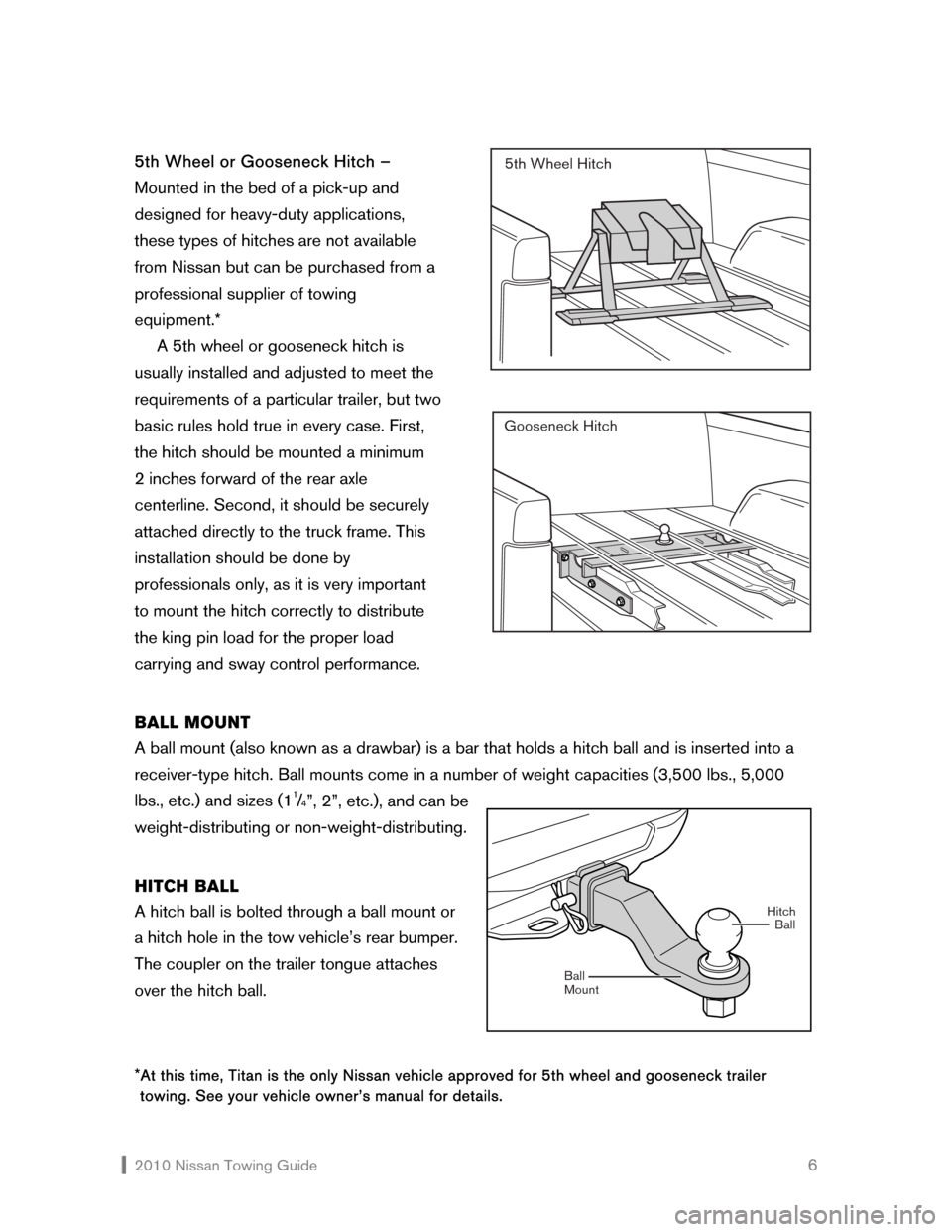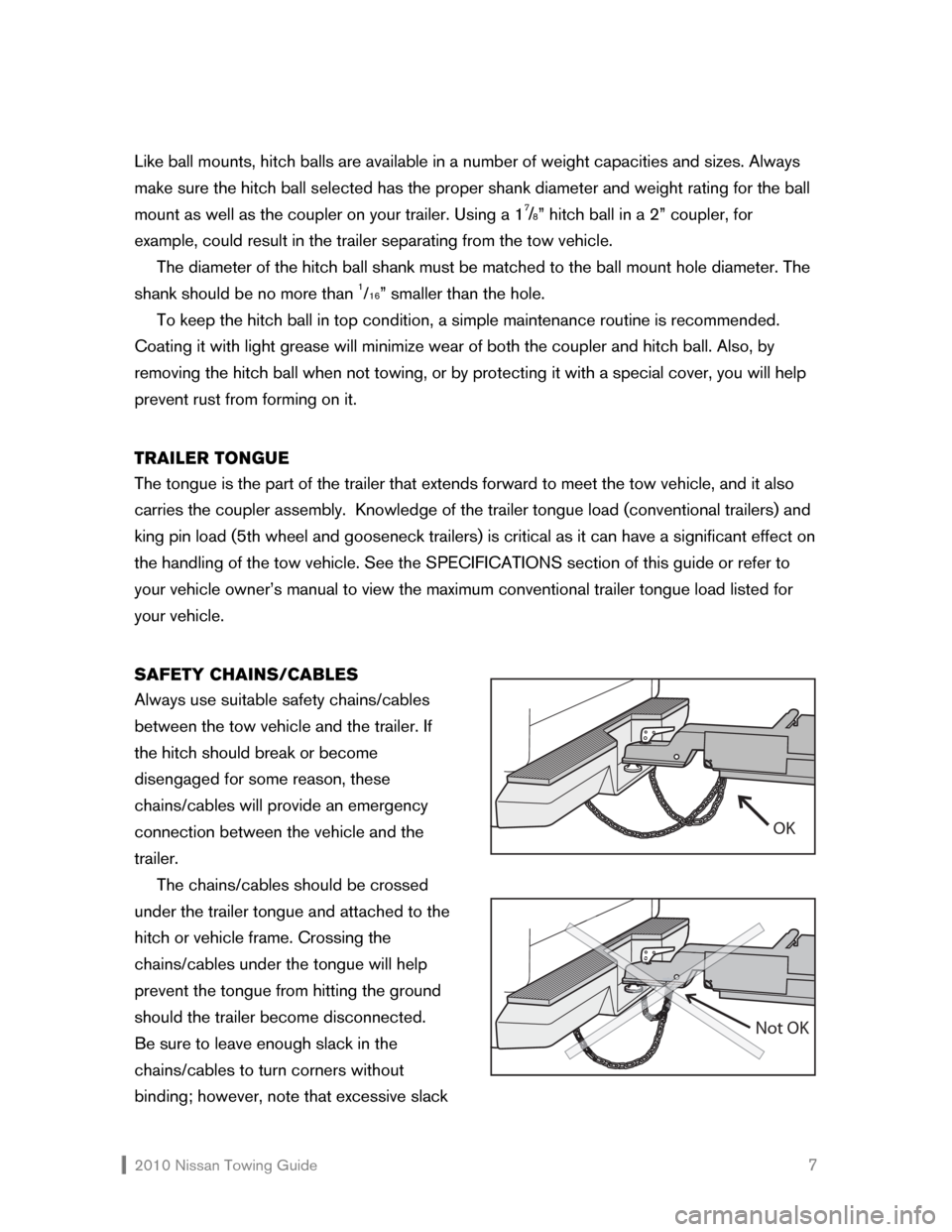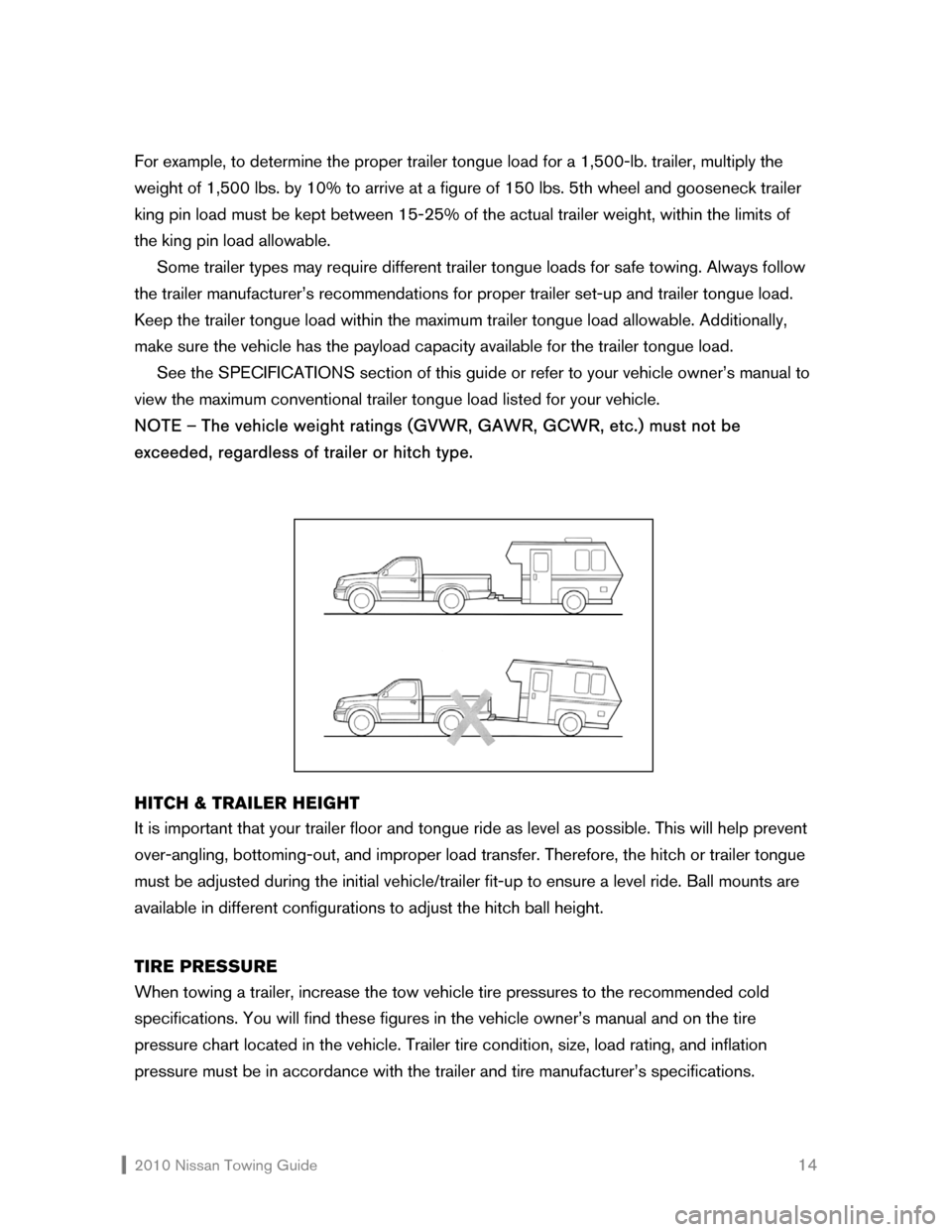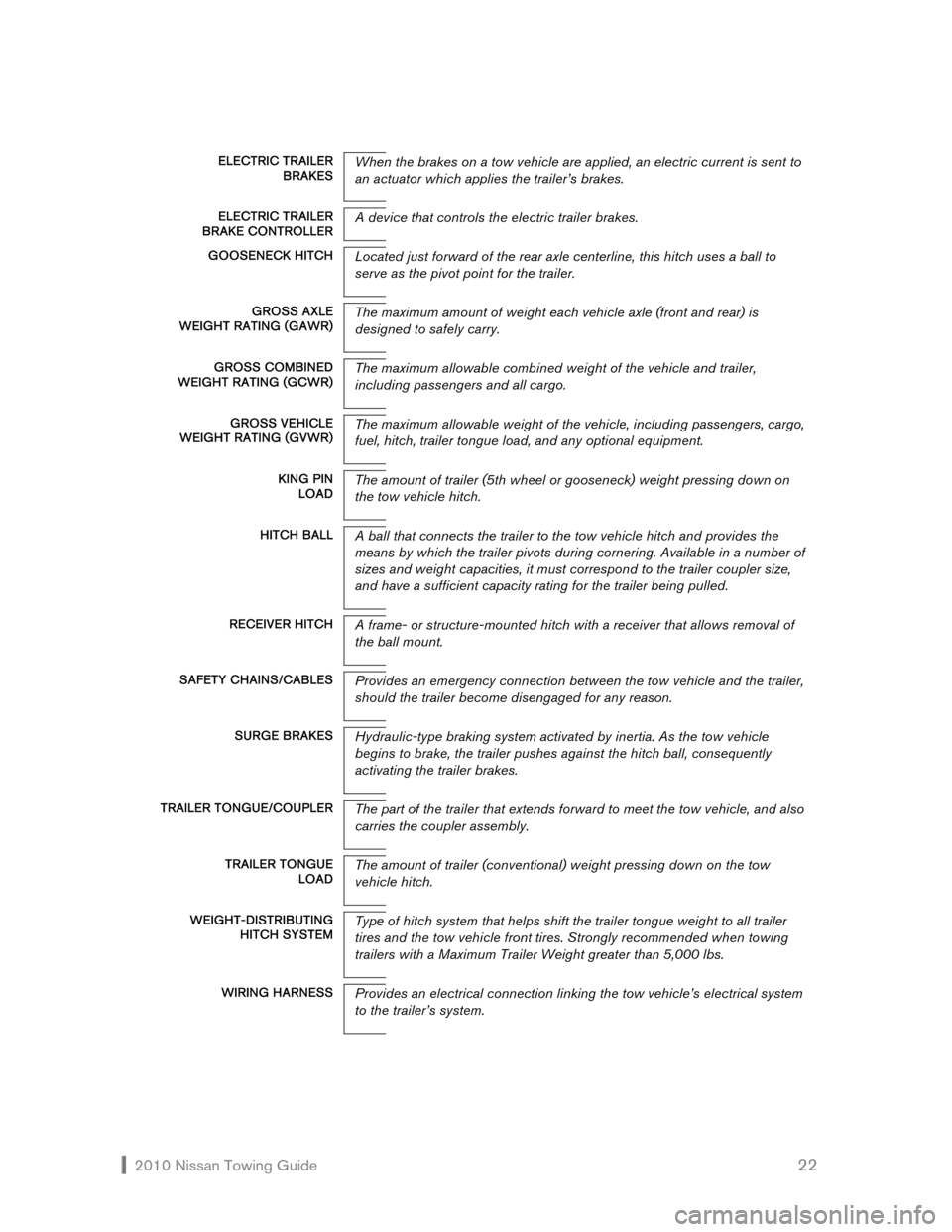2010 NISSAN CUBE wheel size
[x] Cancel search: wheel sizePage 7 of 30

2010 Nissan Towing Guide 6 5th Wheel or Gooseneck Hitch –
Mounted in the bed of a pick-up and
designed for heavy-duty applications,
these types of hitches are not available
from Nissan but can be purchased from a
professional supplier of towing
equipment.*
A 5th wheel or gooseneck hitch is
usually installed and adjusted to meet the
requirements of a particular trailer, but two
basic rules hold true in every case. First,
the hitch should be mounted a minimum
2 inches forward of the rear axle
centerline. Second, it should be securely
attached directly to the truck frame. This
installation should be done by
professionals only, as it is very important
to mount the hitch correctly to distribute
the king pin load for the proper load
carrying and sway control performance.
BALL MOUNT
A ball mount (also known as a drawbar) is a bar that holds a hitch ball and is inserted into a
receiver-type hitch. Ball mounts come in a number of weight capacities (3,500 lbs., 5,000
lbs., etc.) and sizes (1
1/4”, 2”, etc.), and can be
weight-distributing or non-weight-distributing.
HITCH BALL
A hitch ball is bolted through a ball mount or
a hitch hole in the tow vehicle’s rear bumper.
The coupler on the trailer tongue attaches
over the hitch ball.
*At this time, Titan is the only Nissan vehicle approved for 5th wheel and gooseneck trailer
towing. See your vehicle owner’s manual for details.
5th Wheel Hitch
Gooseneck Hitch
Hitch
Mount BallBall
Page 8 of 30

2010 Nissan Towing Guide 7 Like ball mounts, hitch balls are available in a number of weight capacities and sizes. Always
make sure the hitch ball selected has the proper shank diameter and weight rating for the ball
mount as well as the coupler on your trailer. Using a 1
7/8” hitch ball in a 2” coupler, for
example, could result in the trailer separating from the tow vehicle.
The diameter of the hitch ball shank must be matched to the ball mount hole diameter. The
shank should be no more than
1/16” smaller than the hole.
To keep the hitch ball in top condition, a simple maintenance routine is recommended.
Coating it with light grease will minimize wear of both the coupler and hitch ball. Also, by
removing the hitch ball when not towing, or by protecting it with a special cover, you will help
prevent rust from forming on it.
TRAILER TONGUE
The tongue is the part of the trailer that extends forward to meet the tow vehicle, and it also
carries the coupler assembly. Knowledge of the trailer tongue load (conventional trailers) and
king pin load (5th wheel and gooseneck trailers) is critical as it can have a significant effect on
the handling of the tow vehicle. See the SPECIFICATIONS section of this guide or refer to
your vehicle owner’s manual to view the maximum conventional trailer tongue load listed for
your vehicle.
SAFETY CHAINS/CABLES
Always use suitable safety chains/cables
between the tow vehicle and the trailer. If
the hitch should break or become
disengaged for some reason, these
chains/cables will provide an emergency
connection between the vehicle and the
trailer.
The chains/cables should be crossed
under the trailer tongue and attached to the
hitch or vehicle frame. Crossing the
chains/cables under the tongue will help
prevent the tongue from hitting the ground
should the trailer become disconnected.
Be sure to leave enough slack in the
chains/cables to turn corners without
binding; however, note that excessive slack
Not OK
OK
Page 15 of 30

2010 Nissan Towing Guide 14 For example, to determine the proper trailer tongue load for a 1,500-lb. trailer, multiply the
weight of 1,500 lbs. by 10% to arrive at a figure of 150 lbs. 5th wheel and gooseneck trailer
king pin load must be kept between 15-25% of the actual trailer weight, within the limits of
the king pin load allowable.
Some trailer types may require different trailer tongue loads for safe towing. Always follow
the trailer manufacturer’s recommendations for proper trailer set-up and trailer tongue load.
Keep the trailer tongue load within the maximum trailer tongue load allowable. Additionally,
make sure the vehicle has the payload capacity available for the trailer tongue load.
See the SPECIFICATIONS section of this guide or refer to your vehicle owner’s manual to
view the maximum conventional trailer tongue load listed for your vehicle.
NOTE – The vehicle weight ratings (GVWR, GAWR, GCWR, etc.) must not be
exceeded, regardless of trailer or hitch type.
HITCH & TRAILER HEIGHT
It is important that your trailer floor and tongue ride as level as possible. This will help prevent
over-angling, bottoming-out, and improper load transfer. Therefore, the hitch or trailer tongue
must be adjusted during the initial vehicle/trailer fit-up to ensure a level ride. Ball mounts are
available in different configurations to adjust the hitch ball height.
TIRE PRESSURE
When towing a trailer, increase the tow vehicle tire pressures to the recommended cold
specifications. You will find these figures in the vehicle owner’s manual and on the tire
pressure chart located in the vehicle. Trailer tire condition, size, load rating, and inflation
pressure must be in accordance with the trailer and tire manufacturer’s specifications.
Page 23 of 30

2010 Nissan Towing Guide 22
ELECTRIC TRAILER
BRAKES When the brakes on a tow vehicle are applied, an electric current is sent to
an actuator which applies the trailer’s brakes.
ELECTRIC TRAILER
BRAKE CONTROLLER A device that controls the electric trailer brakes.
GOOSENECK HITCH Located just forward of the rear axle centerline, this hitch uses a ball to
serve as the pivot point for the trailer.
GROSS AXLE
WEIGHT RATING (GAWR)
The maximum amount of weight each vehicle axle (front and rear) is
designed to safely carry.
GROSS COMBINED
WEIGHT RATING (GCWR) The maximum allowable combined weight of the vehicle and trailer,
including passengers and all cargo.
GROSS VEHICLE
WEIGHT RATING (GVWR) The maximum allowable weight of the vehicle, including passengers, cargo,
fuel, hitch, trailer tongue load, and any optional equipment.
KING PIN
LOAD The amount of trailer (5th wheel or gooseneck) weight pressing down on
the tow vehicle hitch.
HITCH BALL
A ball that connects the trailer to the tow vehicle hitch and provides the
means by which the trailer pivots during cornering. Available in a number of
sizes and weight capacities, it must correspond to the trailer coupler size,
and have a sufficient capacity rating for the trailer being pulled.
RECEIVER HITCH A frame- or structure-mounted hitch with a receiver that allows removal of
the ball mount.
SAFETY CHAINS/CABLES Provides an emergency connection between the tow vehicle and the trailer,
should the trailer become disengaged for any reason.
SURGE BRAKES
Hydraulic-type braking system activated by inertia. As the tow vehicle
begins to brake, the trailer pushes against the hitch ball, consequently
activating the trailer brakes.
TRAILER TONGUE/COUPLER The part of the trailer that extends forward to meet the tow vehicle, and also
carries the coupler assembly.
TRAILER TONGUE
LOAD The amount of trailer (conventional) weight pressing down on the tow
vehicle hitch.
WEIGHT-DISTRIBUTING
HITCH SYSTEM Type of hitch system that helps shift the trailer tongue weight to all trailer
tires and the tow vehicle front tires. Strongly recommended when towing
trailers with a Maximum Trailer Weight greater than 5,000 lbs.
WIRING HARNESS
Provides an electrical connection linking the tow vehicle’s electrical system
to the trailer’s system.